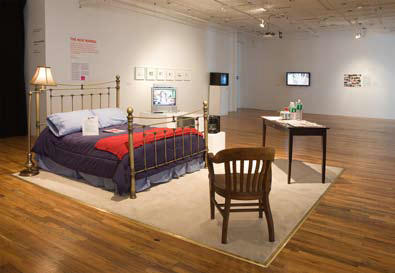
New York
The New Normal
Artists Space
April 26–June 21, 2008
In the aftermath of September 11, 2001, Vice President Dick Cheney justified the expansion of state surveillance (legalized by the Patriot Act) and the abridgement of civil rights by saying that these conditions constituted a “new normalcy.”
For Cheney’s many critics, his comments marked a rupture in traditional understandings of the private sphere. But Cheney was onto something. Spying and prying aside, the internet makes personal information more accessible to more people, and online social networking encourages people to “broadcast” information about themselves to wider and wider audiences. Privacy has become both rare and precious. ‘The New Normal,’ guest- curated by Michael Connor, explored the shifting contours of public and private through thirteen works drawing on intimate information about strangers, public figures, and the artists themselves as raw material or subject matter.
Jennifer and Kevin McCoy’s Vice Presidential Downtime Requirements (2008) turned the tables on the secretive patron saint of surveillance. Guided by a leaked memo listing his hospitality requirements, the artists constructed a Cheney-friendly hotel room in the gallery. But though there was a palpable thrill to intruding on Cheney’s privacy, the accumulated store-bought objects — a queen-size bed, a microwave, a pot of decaf brewing in a coffee maker, bottles of water and cans of Diet Caffeine Free Sprite carefully arranged on a desk — were unremarkable and only dimly enhanced by a television broadcasting ominous Fox News footage.
Introducing the private into art’s rarified public sphere is not a novel strategy. Much feminist art did the same — remember “the personal is political”? — by challenging the traditional gendering of private and public as feminine and masculine, respectively. Two of the strongest works in ‘The New Normal’ reflected this genealogy. Sophie Calle’s Unfinished (2005) documented her struggles to create meaning out of a set of surveillance images captured at an ATM, including shots of a woman being mugged. A playful and performative exposé of artistic process, Calle’s many fruitless tangents sketched out the complex ties between surveillance, the documentary image, capitalism, death, and art’s symbolic value.
In Calle’s practice, confession and surveillance are tinged with longing and desire. Indebted to Calle’s early work, Jill Magid’s Lincoln Ocean Victor Eddy (2006–07) hit a similar register. Magid explored the changing relationship between citizen and state in the information age and consciously deployed seduction as a mode of resistance. Initiated in response to the changing security conditions on the New York subway — increased police presence, random searches, the omnipresent demand for peer surveillance (“if you see something, say something”) — Magid coyly approached a male police officer in 2006 and asked to be searched. Though he refused, Magid persisted and developed a strange intimacy that afforded her unauthorized access to state power. She narrated her experiences in a novella, copies of which were available during ‘The New Normal’ for perusal.
Hasan Elahi utilized an arguably more masculine approach, countering surveillance with “aggressive compliance,” satisfying the state’s demands for transparency and access but reclaiming agency for the citizen. The subject of an invasive FBI investigation based on suspicions of terrorism, Elahi created Tracking Transience, a real-time, self-tracking website that documents his travels — meals eaten, bathrooms used, airports slept in, etcetera. The exhibition included a pair of videos, each composed of seven constantly changing images used to locate him, and a list of credit card transactions distributed across a grid of shiny metal sheets. In both cases, viewers were overwhelmed by the sheer volume of information, which limited its value as intelligence. It was precisely this slippery threshold between information and noise that was key to the project’s success as a political act.
The omnipresence of state surveillance has inspired a comparable omnipresence of exhibitions and artworks exploring the subject, beginning with the eerily prescient ‘CTRL [SPACE]: Rhetorics of Surveillance from Bentham to Big Brother,’ a survey that opened at Karlsruhe’s ZKM Center for Art and Media a month after 9/11. While ‘The New Normal’ covered similar terrain, it also tried, somewhat unsuccessfully, to move beyond the public and political territory of surveillance and control by focusing on the private sphere as a unit of sociological analysis.
Jon Thomson and Alison Craighead’s Beacon (2007), a real-time video projection of phrases entered by anonymous users into internet search engines, demonstrated how the web documents and archives our wants, desires, habits, and curiosities in highly accessible formats. Strangely engrossing, this fluttering collection of keywords produced a linguistic portrait of the internet and reproduced the slight substance of our lives.
Mohamed Camara’s Les Rideaux de Mohamed (The Curtains of Mohamed) (2004) delved into domestic space. Fearing that his camera would be stolen on the streets, Camara documented interiors of friends’ and relatives’ domiciles in his hometown of Bamako. Focusing on the flapping, diaphanous curtains that separate private and public, Camara’s beautiful, meditative video emphasized the fragility of the divide.
‘The New Normal’ could have benefited from the nuances of what Paul Virilio calls the “democratization of voyeurism.” The social networking tools that define Web 2.0 are transactional, after all, and our contemporary obsession with reality television and celebrity culture suggests that we are privacy violators as well. Acknowledging that we agents who desire and demand intimate access to the lives of others may be the key to unlocking the ethical dimensions and implications of Cheney’s bizarre “new normalcy.”